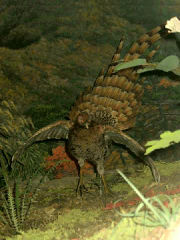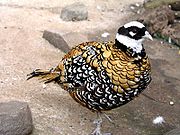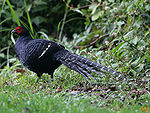
Syrmaticus
Encyclopedia
The genus
Syrmaticus contains the five species
of long-tailed pheasant
s. The males have short spurs and usually red facial wattle
s, but otherwise differ wildly in appearance. The hens (females) and chicks pattern of all the species have a rather conservative and plesiomorphic drab brown color pattern.
5 species
are generally accepted in this genus.

based on DNA sequence
data, but this does not seem well warranted; the molecular evolution
in this genus has been unusual and can easily mislead molecular phylogenetic studies and makes molecular clock
s unreliable. At least in the cytochrome b
sequence transition
s have outnumbered transversion
s to an extent rarely seen in other bird
s. Transition-transversion frequencies in mtDNA control region are by contrast more like those usually seen in birds, but this region of the mitochondrial genome has been evolving unusually slowly in Syrmaticus.
Still, the phylogeny and evolution of the long-tailed pheasants can be considered resolved to satisfaction by now. It was long accepted that the three southeastern species – which all have bright white wing-bands of a type not found in any close relative and differ little except in the amount and concentration of eumelanins in their plumage – form a clade
. However, the two others are not as closely related to each other as was previously thought, representing two lineages that diverged independently from the main lineage instead of being sister species. These – Reeves's Pheasant
(S. reevesii) and the Copper Pheasant
(S. soemmerringii) – are sometimes placed in monotypic
genera, but as noted above though this may eventually turn out to be warranted it is not well supported by the available evidence.
origin, the genus Syrmaticus originated from some pheasant species inhabiting the submontane to montane
subtropical rainforest
at the northwestern end of the Himalayas
some 10-7 million years ago (mya) during the Tortonian
– the genus is thus about as old as Gallus
and originated somewhat before the time the ancestors of human
s and chimpanzee
s finally diverged. The original long-tailed pheasant (which probably did not have an overly elongated tail back then) diverged from the ancestors of the Phasianus pheasants, which subsequently expanded across temperate
Asia
northwastwards of the initial range of Syrmaticus.
 Reeves's Pheasant
Reeves's Pheasant
(S. reevesi) is probably derived from ancestral stock that remained in the general area of the genus' origin, adapting to the local conditions and evolving numerous peculiar male apomorphies, such as the lack of facial wattles (which judging from their presence in Phasianus were present in the ancestral Syrmaticus too), the golden body plumage, the conspicuous head stripes or the immensely long tail.
The ancestors of the remaining long-tailed pheasants separated from those of Reeve's Pheasant perhaps as early as the latter Tortonian but probably rather some time during the Messinian
. These birds spread – perhaps in response to ecological changes brought about by the climate change
as the world turned into the last ice age – coastwards and to the southwest into the hills and lowlands of eastern Indochina
and southeastern China
. Around the Miocene
-Pliocene
boundary, roughly 5.4 mya or so, the ancestors of the Copper Pheasant
(S. soemmerringii) separated from the mainland lineage and probably settled Japan
at that time or soon thereafter.
 Perhaps the white wing-band was already present by that time; as the Copper Pheasant has a highly apomorphic coloration with reduced sexual dimorphism
Perhaps the white wing-band was already present by that time; as the Copper Pheasant has a highly apomorphic coloration with reduced sexual dimorphism
, it may well have lost such a trait after it settled Japan. But it might also have evolved only after the Copper Pheasant ancestors had split from those of the species displaying the wing-band today. However that may be, the minor plumage differences of the wing-banded species suggest that their last common ancestor looked almost identical to the living Mrs. Hume's Pheasant (S. humiae). At some point during the Pliocene – probably around 2.8 mya during the Piacenzian
– the ancestors of the Mikado Pheasant
(S. mikado) settled Taiwan
, apparently during the period when that island separated from the mainland and alternated between being a peninsula and an island for some time. They were finally isolated no later than the Late Pliocene; the species is melanistic, suggesting a small founder population
. The adjacent mainland population split into the subtropical and partially leucistic
Elliot's Pheasant
(S. ellioti) and the tropical Mrs. Hume's Pheasant only in the Middle Pleistocene
, around half a million years ago. This divergence was probably in some way connected to climate changes at the Günz-Mindel interglacial to Mindel boundary, when mountains in the region became dry and at times icebound. The Nanling Mountains region marks the present-day boundary between these sister species and is not inhabited by either.
Genus
In biology, a genus is a low-level taxonomic rank used in the biological classification of living and fossil organisms, which is an example of definition by genus and differentia...
Syrmaticus contains the five species
Species
In biology, a species is one of the basic units of biological classification and a taxonomic rank. A species is often defined as a group of organisms capable of interbreeding and producing fertile offspring. While in many cases this definition is adequate, more precise or differing measures are...
of long-tailed pheasant
Pheasant
Pheasants refer to some members of the Phasianinae subfamily of Phasianidae in the order Galliformes.Pheasants are characterised by strong sexual dimorphism, males being highly ornate with bright colours and adornments such as wattles and long tails. Males are usually larger than females and have...
s. The males have short spurs and usually red facial wattle
Wattle
Wattle may refer to:*Wattle , a fleshy growth hanging from the head or neck of certain animals.*Wattle is another term for Congenital cartilaginous rest of the neck...
s, but otherwise differ wildly in appearance. The hens (females) and chicks pattern of all the species have a rather conservative and plesiomorphic drab brown color pattern.
5 species
Species
In biology, a species is one of the basic units of biological classification and a taxonomic rank. A species is often defined as a group of organisms capable of interbreeding and producing fertile offspring. While in many cases this definition is adequate, more precise or differing measures are...
are generally accepted in this genus.

Systematics and taxonomy
The genus is occasionally included in PhasianusPhasianus
The "typical" pheasant genus Phasianus in the family Phasianidae consists of at least one species. Both Phasianus and "pheasant" comes from the Greek word phāsiānos, meaning " of the Phasis". Phasis is the ancient name of the main river of western Georgia, currently called the Rioni.The Common...
based on DNA sequence
DNA sequence
The sequence or primary structure of a nucleic acid is the composition of atoms that make up the nucleic acid and the chemical bonds that bond those atoms. Because nucleic acids, such as DNA and RNA, are unbranched polymers, this specification is equivalent to specifying the sequence of...
data, but this does not seem well warranted; the molecular evolution
Evolution
Evolution is any change across successive generations in the heritable characteristics of biological populations. Evolutionary processes give rise to diversity at every level of biological organisation, including species, individual organisms and molecules such as DNA and proteins.Life on Earth...
in this genus has been unusual and can easily mislead molecular phylogenetic studies and makes molecular clock
Molecular clock
The molecular clock is a technique in molecular evolution that uses fossil constraints and rates of molecular change to deduce the time in geologic history when two species or other taxa diverged. It is used to estimate the time of occurrence of events called speciation or radiation...
s unreliable. At least in the cytochrome b
Cytochrome b
Cytochrome b/b6 is the main subunit of transmembrane cytochrome bc1 and b6f complexes. In addition, it commonly refers to a region of mtDNA used for population genetics and phylogenetics.- Function :...
sequence transition
Transition (genetics)
In genetics, a transition is a point mutation that changes a purine nucleotide to another purine or a pyrimidine nucleotide to another pyrimidine . Approximately two out of three single nucleotide polymorphisms are transitions....
s have outnumbered transversion
Transversion
In molecular biology, transversion refers to the substitution of a purine for a pyrimidine or vice versa. It can only be reverted by a spontaneous reversion. Because this type of mutation changes the chemical structure dramatically, the consequences of this change tend to be more drastic than those...
s to an extent rarely seen in other bird
Bird
Birds are feathered, winged, bipedal, endothermic , egg-laying, vertebrate animals. Around 10,000 living species and 188 families makes them the most speciose class of tetrapod vertebrates. They inhabit ecosystems across the globe, from the Arctic to the Antarctic. Extant birds range in size from...
s. Transition-transversion frequencies in mtDNA control region are by contrast more like those usually seen in birds, but this region of the mitochondrial genome has been evolving unusually slowly in Syrmaticus.
Still, the phylogeny and evolution of the long-tailed pheasants can be considered resolved to satisfaction by now. It was long accepted that the three southeastern species – which all have bright white wing-bands of a type not found in any close relative and differ little except in the amount and concentration of eumelanins in their plumage – form a clade
Clade
A clade is a group consisting of a species and all its descendants. In the terms of biological systematics, a clade is a single "branch" on the "tree of life". The idea that such a "natural group" of organisms should be grouped together and given a taxonomic name is central to biological...
. However, the two others are not as closely related to each other as was previously thought, representing two lineages that diverged independently from the main lineage instead of being sister species. These – Reeves's Pheasant
Reeves's Pheasant
The Reeves's Pheasant, Syrmaticus reevesii, is a large pheasant within the genus Syrmaticus. It is endemic to China....
(S. reevesii) and the Copper Pheasant
Copper Pheasant
The Copper Pheasant, Syrmaticus soemmerringii also known as Soemmerring's Pheasant is a large, up to 136cm long, pheasant with a rich coppery chestnut plumage, yellowish bill, brown iris and red facial skin. The female is a brown bird with greyish brown upperparts and buff barred dark brown below...
(S. soemmerringii) – are sometimes placed in monotypic
Monotypic
In biology, a monotypic taxon is a taxonomic group with only one biological type. The term's usage differs slightly between botany and zoology. The term monotypic has a separate use in conservation biology, monotypic habitat, regarding species habitat conversion eliminating biodiversity and...
genera, but as noted above though this may eventually turn out to be warranted it is not well supported by the available evidence.
Evolution
Of Late MioceneLate Miocene
The Late Miocene is a sub-epoch of the Miocene Epoch made up of two stages. The Tortonian and Messinian stages comprise the Late Miocene sub-epoch....
origin, the genus Syrmaticus originated from some pheasant species inhabiting the submontane to montane
Montane
In biogeography, montane is the highland area located below the subalpine zone. Montane regions generally have cooler temperatures and often have higher rainfall than the adjacent lowland regions, and are frequently home to distinct communities of plants and animals.The term "montane" means "of the...
subtropical rainforest
Rainforest
Rainforests are forests characterized by high rainfall, with definitions based on a minimum normal annual rainfall of 1750-2000 mm...
at the northwestern end of the Himalayas
Himalayas
The Himalaya Range or Himalaya Mountains Sanskrit: Devanagari: हिमालय, literally "abode of snow"), usually called the Himalayas or Himalaya for short, is a mountain range in Asia, separating the Indian subcontinent from the Tibetan Plateau...
some 10-7 million years ago (mya) during the Tortonian
Tortonian
The Tortonian is in the geologic timescale an age or stage of the late Miocene that spans the time between 11.608 ± 0.005 Ma and 7.246 ± 0.005 Ma . It follows the Serravallian and is followed by the Messinian....
– the genus is thus about as old as Gallus
Gallus
Gallus may refer to:People* several ancient Romans; see Gallus * Gaius Cornelius Gallus , Roman poet, orator and politician *Saint Gall , 7th century...
and originated somewhat before the time the ancestors of human
Human
Humans are the only living species in the Homo genus...
s and chimpanzee
Chimpanzee
Chimpanzee, sometimes colloquially chimp, is the common name for the two extant species of ape in the genus Pan. The Congo River forms the boundary between the native habitat of the two species:...
s finally diverged. The original long-tailed pheasant (which probably did not have an overly elongated tail back then) diverged from the ancestors of the Phasianus pheasants, which subsequently expanded across temperate
Temperate
In geography, temperate or tepid latitudes of the globe lie between the tropics and the polar circles. The changes in these regions between summer and winter are generally relatively moderate, rather than extreme hot or cold...
Asia
Asia
Asia is the world's largest and most populous continent, located primarily in the eastern and northern hemispheres. It covers 8.7% of the Earth's total surface area and with approximately 3.879 billion people, it hosts 60% of the world's current human population...
northwastwards of the initial range of Syrmaticus.

Reeves's Pheasant
The Reeves's Pheasant, Syrmaticus reevesii, is a large pheasant within the genus Syrmaticus. It is endemic to China....
(S. reevesi) is probably derived from ancestral stock that remained in the general area of the genus' origin, adapting to the local conditions and evolving numerous peculiar male apomorphies, such as the lack of facial wattles (which judging from their presence in Phasianus were present in the ancestral Syrmaticus too), the golden body plumage, the conspicuous head stripes or the immensely long tail.
The ancestors of the remaining long-tailed pheasants separated from those of Reeve's Pheasant perhaps as early as the latter Tortonian but probably rather some time during the Messinian
Messinian
The Messinian is in the geologic timescale the last age or uppermost stage of the Miocene. It spans the time between 7.246 ± 0.005 Ma and 5.332 ± 0.005 Ma...
. These birds spread – perhaps in response to ecological changes brought about by the climate change
Climate change
Climate change is a significant and lasting change in the statistical distribution of weather patterns over periods ranging from decades to millions of years. It may be a change in average weather conditions or the distribution of events around that average...
as the world turned into the last ice age – coastwards and to the southwest into the hills and lowlands of eastern Indochina
Indochina
The Indochinese peninsula, is a region in Southeast Asia. It lies roughly southwest of China, and east of India. The name has its origins in the French, Indochine, as a combination of the names of "China" and "India", and was adopted when French colonizers in Vietnam began expanding their territory...
and southeastern China
China
Chinese civilization may refer to:* China for more general discussion of the country.* Chinese culture* Greater China, the transnational community of ethnic Chinese.* History of China* Sinosphere, the area historically affected by Chinese culture...
. Around the Miocene
Miocene
The Miocene is a geological epoch of the Neogene Period and extends from about . The Miocene was named by Sir Charles Lyell. Its name comes from the Greek words and and means "less recent" because it has 18% fewer modern sea invertebrates than the Pliocene. The Miocene follows the Oligocene...
-Pliocene
Pliocene
The Pliocene Epoch is the period in the geologic timescale that extends from 5.332 million to 2.588 million years before present. It is the second and youngest epoch of the Neogene Period in the Cenozoic Era. The Pliocene follows the Miocene Epoch and is followed by the Pleistocene Epoch...
boundary, roughly 5.4 mya or so, the ancestors of the Copper Pheasant
Copper Pheasant
The Copper Pheasant, Syrmaticus soemmerringii also known as Soemmerring's Pheasant is a large, up to 136cm long, pheasant with a rich coppery chestnut plumage, yellowish bill, brown iris and red facial skin. The female is a brown bird with greyish brown upperparts and buff barred dark brown below...
(S. soemmerringii) separated from the mainland lineage and probably settled Japan
Japan
Japan is an island nation in East Asia. Located in the Pacific Ocean, it lies to the east of the Sea of Japan, China, North Korea, South Korea and Russia, stretching from the Sea of Okhotsk in the north to the East China Sea and Taiwan in the south...
at that time or soon thereafter.

Sexual dimorphism
Sexual dimorphism is a phenotypic difference between males and females of the same species. Examples of such differences include differences in morphology, ornamentation, and behavior.-Examples:-Ornamentation / coloration:...
, it may well have lost such a trait after it settled Japan. But it might also have evolved only after the Copper Pheasant ancestors had split from those of the species displaying the wing-band today. However that may be, the minor plumage differences of the wing-banded species suggest that their last common ancestor looked almost identical to the living Mrs. Hume's Pheasant (S. humiae). At some point during the Pliocene – probably around 2.8 mya during the Piacenzian
Piacenzian
The Piacenzian is in the international geologic timescale the upper stage or latest age of the Pliocene. It spans the time between 3.6 ± 0.005 Ma and 2.588 ± 0.005 Ma...
– the ancestors of the Mikado Pheasant
Mikado Pheasant
The Mikado Pheasant, Syrmaticus mikado, is a gamebird in the pheasant family Phasianidae of the order Galliformes, gallinaceous birds.-Distribution and habitat:The Mikado Pheasant is endemic to mountainous regions of Taiwan...
(S. mikado) settled Taiwan
Taiwan
Taiwan , also known, especially in the past, as Formosa , is the largest island of the same-named island group of East Asia in the western Pacific Ocean and located off the southeastern coast of mainland China. The island forms over 99% of the current territory of the Republic of China following...
, apparently during the period when that island separated from the mainland and alternated between being a peninsula and an island for some time. They were finally isolated no later than the Late Pliocene; the species is melanistic, suggesting a small founder population
Founder effect
In population genetics, the founder effect is the loss of genetic variation that occurs when a new population is established by a very small number of individuals from a larger population. It was first fully outlined by Ernst Mayr in 1942, using existing theoretical work by those such as Sewall...
. The adjacent mainland population split into the subtropical and partially leucistic
Leucistic
Leucism is a condition characterized by reduced pigmentation in animals and humans. Unlike albinism, it is caused by a reduction in all types of skin pigment, not just melanin.- Details :...
Elliot's Pheasant
Elliot's Pheasant
The Elliot's Pheasant, Syrmaticus ellioti also known as Bar-backed Pheasant is a large, up to 80 cm long, brown and white pheasant with a black throat, chestnut brown upperparts plumage, white belly, nape and wingbars, red bare facial skin and long rusty-barred whitish tail...
(S. ellioti) and the tropical Mrs. Hume's Pheasant only in the Middle Pleistocene
Middle Pleistocene
The Middle Pleistocene, more specifically referred to as the Ionian stage, is a period of geologic time from ca. 781 to 126 thousand years ago....
, around half a million years ago. This divergence was probably in some way connected to climate changes at the Günz-Mindel interglacial to Mindel boundary, when mountains in the region became dry and at times icebound. The Nanling Mountains region marks the present-day boundary between these sister species and is not inhabited by either.

